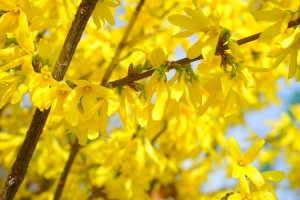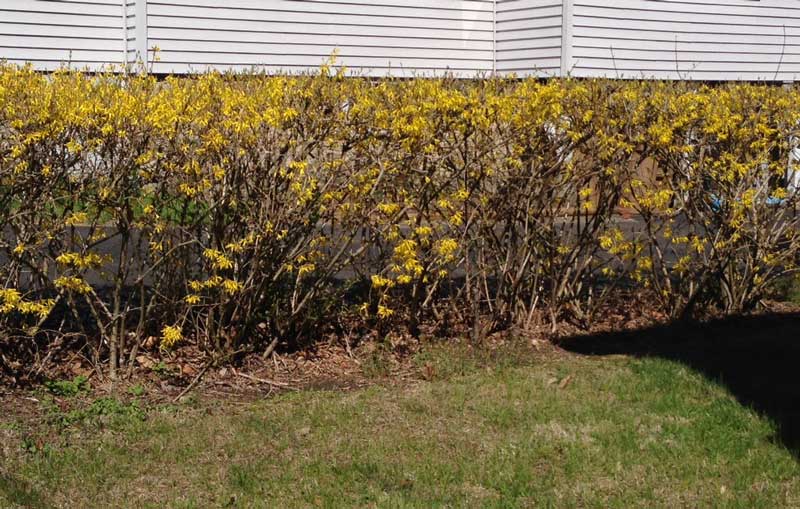Forsythia is one of the most common shrubs grown in home gardens, but it is also one of the most mistreated.
Many homeowners buy a forsythia dreaming about the bright yellow flowers that appear early in spring. That’s why you put it near a window, door, or path so you can see it clearly when it blooms. After three years, it’s grown into a 10-foot monster that blocks your view and forces you to go around it to get inside.
There are a few smaller types of forsythia, but most of them naturally grow in the shape of a vase and are about 10 feet tall and wide. That’s a big shrub! Far bigger than the space most of us give it.
Because of this, they need a lot of pruning, which often looks more like butchery.
How do you keep your forsythia in check so it doesn’t turn into a meatball or a mess of stems without flowers?
Forsythia is a popular spring-blooming shrub known for its bright yellow flowers. Many homeowners wonder if it’s okay to trim forsythia in the winter or if it’s better to wait until spring or summer. The short answer is yes, you can trim forsythia in winter. However, the ideal time to prune depends on your goals.
Why Prune Forsythia
There are a few key reasons you may want to prune your forsythia
- To maintain size and shape
- To rejuvenate old, overgrown shrubs
- To remove dead or damaged branches
- To encourage more profuse flowering
Pruning helps keep forsythia neat, healthy and flowering abundantly year after year. Left unpruned, these fast-growing shrubs can quickly get leggy wild, and out of control.
When to Prune Forsythia
Forsythia can be pruned in winter, spring, or summer depending on your specific needs:
Winter
Pruning in late winter or early spring (before new growth emerges) is best for rejuvenating overgrown, neglected shrubs. Cut all stems back to 4-6 inches above the ground. This severe pruning will remove most flower buds for that season, but the shrub will regrow and bloom again within a couple years.
Winter pruning is also a good time to remove dead or damaged wood.
Spring
Pruning immediately after flowering in spring removes spent blooms and shapes the plant without sacrificing next year’s flower buds. This is the best time to prune if abundant flowers are desired.
Cut 1-4 of the oldest, thickest stems at ground level and shorten unwanted new growth. Spring pruning maintains size and form while allowing maximum flowers.
Summer
Summer pruning can be done to shape and thin as needed. But avoid heavy pruning during summer heat. Light tip pruning or pinching helps direct growth.
Remove any dead or diseased wood promptly.
How to Trim Forsythia in Winter
Follow these tips for pruning overgrown forsythias in winter:
-
Wait until the plant is fully dormant in late winter/early spring.
-
Use loppers or a pruning saw to remove up to one-third of the oldest, tallest stems at ground level.
-
Remove any dead, damaged, or crossing branches.
-
Thin inner growth to open up the center of the shrub.
-
Shape and balance the plant as desired.
-
Leave 4-6 inches of stem when cutting back severely overgrown plants.
Your forsythia may look nearly dead after a hard winter pruning, but don’t worry! Healthy new shoots will emerge from the remaining stem tissue. Proper pruning stimulates regeneration and rejuvenation.
Forsythia Pruning Tips
-
Disinfect pruning tools before and after each cut to prevent disease transmission.
-
Prune stem tips just above an outward facing bud or branch.
-
make clean cuts without leaving stubs.
-
Remove suckers sprouting from the root system unless needed to fill a gap.
-
Wear gloves and safety goggles when pruning. Forsythia stems are flexible and can whip back.
-
Prune strategically for best results. Never shear or top the shrub like a hedge.
Benefits of Winter Pruning
Pruning mature, overgrown forsythia in winter has several advantages:
-
Promotes vigorous new growth from the base
-
Rejuvenates old, neglected shrubs
-
Allows you to restart with a blank slate
-
Removes dead, damaged, and diseased wood
-
Opens up the interior to light and air
-
Reduces height and width as desired
-
Encourages the plant to bloom again
As long as some live stem tissue remains, even a severely pruned forsythia will recover and regrow. The spring after winter pruning, expect fewer but likely larger blooms. Flowering will increase over the next couple seasons as the rejuvenated shrub gains strength.
Yes, you can trim back your forsythia in winter. In fact, late winter is an ideal time to renovate overgrown, mature shrubs. Just be prepared to sacrifice some of the next spring’s bloom. But proper pruning encourages new growth and flowering in future years. With a bit of patience, you can restore that leggy old forsythia to its former floral glory.

How to Prune Forsythia
 There are two approaches to pruning forsythia, depending on what state it’s in.
There are two approaches to pruning forsythia, depending on what state it’s in.
If it’s too big or too overgrown for the space, cut it all the way down to the ground. That’s right – whack it to the ground. As long as the forsythia shrub was healthy to begin with, this type of rejuvenation pruning seems to make it grow back quickly.
Forsythia are big shrubs, so even if you prune them to make them look better, you’ll probably end up back where you started pretty quickly. In just one season, the stems can grow 8 feet long!
If you want to change the shape of the bush or make it look better, you should thin it out. This involves cutting between ¼ and 1/3 of the oldest stems to the ground; do this every year. Focus on stems that are damaged, trailing on the ground, crossing, or look out of place.
Be sure to always take a few of the larger stems out of the center of the shrub. Because of this, the forsythia can grow new leaves and flowers all over the shrub, not just at the tips of the branches. It also lets sunlight reach the middle of the plant.
In no way should you just cut the branches off at the tips or halfway down the stem. Forsythia respond to that type of pruning by putting out tons of new growth just below the cut. You’ll end up with a tangled mess of branches with flowers only at the tips of the branches and a bigger shrub.
Forsythia is sometimes used as a hedge, and its branches are kept very short by people who do this. While I don’t recommend this (there are other shrubs that make much better hedges), this approach can work. Forsythia shrubs that are pruned in this way don’t have many flowers and the inside of the hedge is made up of thin, tangled branches with no leaves. They need to be sheared several times a year to keep them looking somewhat neat. But if you like this idea, cut back the bush with hedge shears or an electric hedge trimmer three or four times during the growing season when it starts to look too big.

When And How To Prune Your Forsythia Shrub With David Domoney
FAQ
How do you prune an old overgrown forsythia?
What happens if you don’t prune forsythia?
How do you keep forsythia blooming?
Will forsythia bloom after cut?
- The Ultimate Guide to Growing Strawberries in Raised Beds - August 8, 2025
- No-Dig Garden Beds: The Easiest Way to Grow a Beautiful Garden - August 6, 2025
- How to Protect and Preserve Wood for Raised Garden Beds - August 6, 2025
